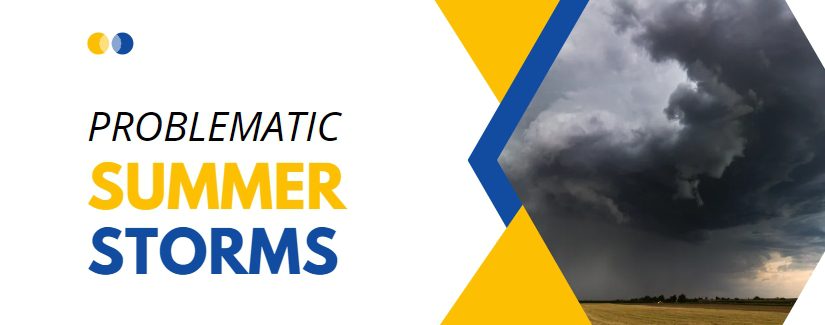With the arrival of summer, come the dangers, such as summer storms. These natural phenomena are not only breathtaking to watch, but they can also be dangerous to commercial flat roofs. Businesses must be aware of the damage that summer storms may cause to ensure their roofing system’s longevity and durability. This blog will explore the different threats that summer storms can pose to flat commercial roofs and the preventive measures to minimize the damage.
Heavy Rainfall
Summer storms can bring heavy rainfall that can overwhelm drainage systems, causing water to pool on flat roofs. Standing water on a roof can cause leaks, damage to roofing materials, and structural problems. Regular maintenance and inspections, such as clearing drainage systems, can help to prevent water accumulation and protect against issues related to water.
High Winds
Strong winds are often a feature of summer storms, and they can cause havoc to commercial flat roofs. Strong gusts of wind can cause roofing materials to be lifted and displaced, especially if the roof is not secured properly. Damaged or loose components can expose the layers below, causing leaks and additional damage. Regular roof inspections will strengthen the roof by identifying and repairing any loose or compromised sections.
Hail and Flying debris
Summer storms can also bring hail or flying debris. Both elements can cause significant damage to flat commercial roofs. Hailstones may dent or puncture roof materials, which compromises their protective properties. Debris, such as airborne or tree branch debris, can also cause roof abrasions and tears. Installing impact-resistant roofing materials and performing post-storm assessments to identify any damage and correct it promptly can help protect against hail and debris-related harm.
Thunderstorms are often associated with summer weather patterns and increase the risk of lightning. Although flat roofs are not attracted to lightning, a lightning strike that is either nearby or direct can be dangerous. Damage to electrical systems, such as rooftop equipment, could lead to system failure or fire hazards. Lightning protection systems, grounding methods, and regular inspections of electrical systems can reduce the risk associated with lightning.
Commercial flat roofs need to be protected from summer storms. This is an important aspect of maintaining your property. Businesses can strengthen their roofing systems by taking proactive measures. To ensure that commercial flat roofs are durable, safe, and long-lasting, regular inspections, maintenance, and repairs must be performed. Businesses can minimize disruptions and weather storms by investing in prevention strategies.
We encourage you to reach out to us to schedule twice-per-year inspections for your commercial roof!

